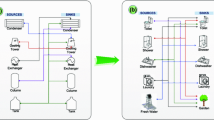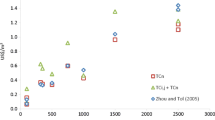Abstract
It is strategically important to optimize the pipe network used for reclaimed urban water reuse. A large and complex system model is developed, with the minimum total annual cost of the pumping station and pipe engineering as objective functions, the head loss in the divided pipe segment as the coupling constraint, the economic flow velocity and the optimal diameter of a standard pipe as feasible domain constraints, and the design head and diameter of the pipe as decision variables. The problem is solved by combining the ratio of the discrete enumeration of the design head to the decomposition-dynamic programming aggregation of the large-scale system. This strategy can solve the problem of the optimal pipe diameter in each section of the pipe network engineering under a fixed design head of the pressurized pumping station. On this basis, the annual cost of reclaimed water reuse pipe network engineering is compared under the different design heads of the pressurized pumping stations, allowing the optimal design scheme for reclaimed water reuse pipe network engineering to be obtained. At the same time, the optimal design head of the pressurized pumping station and the optimal pipe diameter of each section can be identified. This can provide a theoretical reference for the optimal design of urban and rural water pipe networks.






Similar content being viewed by others
Data Availability
All data, models, and code generated or used during the study appear in the submitted article.
References
Anand A, Galelli S, Lakshminarayanan S et al (2013) Coordinating multiple model predictive controllers for the management of large-scale water systems. J Hydroinf 15(2):293–305
Benyamin B, Endang YH, Guntur (2016) Dinoflagellates Habs potential responsible for paralytic shellfish poisoning (Psp) in inner Ambon Bay - Maluku - Indonesia. Int J Sci Technol Res 5(6):287–291
Boo CJ, Kim HC, Kang MJ (2015) Energy cost saving control of water reuse pumping system using particle swarm optimization. Journal of the Korea Academia-Industrial Cooperation Society 16(1):860–867
Creoca E, Alvisi S, Franchini M (2015) Multistep approach for optimizing design and operation of the C-town pipe network model. Journal of Water Resources Planning & Management 142(5)
Du J, Wang HW, Meng XQ et al (2005) Optimal design of wastewater reuse network with multiple contaminants based on hybrid optimization algorithm. Acta Pet Sin 21(1):68–75
Fan YP, Chen WP, Jiao WT et al (2015) Cost-benefit analysis of reclaimed wastewater reuses in Beijing. Desalination & Water Treatment 53(5):1224–1233
Gunhui C, Taewoong K, Jeongho L et al (2010) Optimization of water reuse system under uncertainty. Journal of Korea Water Resources Association 43(2):131–138
Hooda N, Damani OP (2017) A system for optimal design of pressure constrained branched piped water networks. Procedia Engineering 186:349–356
Lee EJ, Criddle CS, Geza M, Cath TY, Freyberg DL (2018) Decision support toolkit for integrated analysis and design of reclaimed water infrastructure. Water Res 134:234–252
Li YN, Ma PH, Hu YJ et al (2016) Optimal design of the gravity micro-irrigation pipe network for irrigation district. J Hydraul Eng 47(11):1371–1379
Sarbu I, Ostafe G (2016) Optimal design of urban water supply pipe networks. Urban Water J 13(5):521–535
Tian JD, Cheng JL, Gong Y (2017) Optimization of municipal pressure pumping station layout and sewage pipe network design. Eng Optim 6:1–11
Waldrip SH, Niven RK, Abel M et al (2015) Maximum entropy analysis of hydraulic pipe networks. J Hydraul Eng 142(9):180–186
Wang YB, Liu D, Cao XC et al (2017) Agricultural water rights trading and virtual water export compensation coupling model: a case study of an irrigation district in China. Agric Water Manag 180(31):99–106
Zhang WN (2013) Water network design and management via stochastic programming. University of Arizona
Zhang JW, Wang X, Liu P et al (2017) Assessing the weighted multi-objective adaptive surrogate model optimization to derive large-scale reservoir operating rules with sensitivity analysis. J Hydrol 544:613–627
Zhao GF, Song XJ, Cheng L (2016) Optimal decision for reclamation of multiple pieces tideland area by large system decomposition and dynamic programming method. Journal of Irrigation & Drainage 35(4):26–31
Acknowledgements
We would like to thank the National Science and Technology Support (2015BAB07B01) and the Pumping Station Optimal Operation of the Eastern Route of South-to-North Water Transfer for financial support.
Author information
Authors and Affiliations
Corresponding author
Additional information
Publisher’s Note
Springer Nature remains neutral with regard to jurisdictional claims in published maps and institutional affiliations.
Highlights
1. This paper proposed a method to solve the optimization problem of a recycled water reuse pipe network based on the discrete enumeration method and large-scale system decomposition-dynamic programming aggregation.
2. The annual cost of reclaimed water reuse pipe network engineering is compared under the different design heads of pressurized pumping stations, allowing the optimal design scheme for reclaimed water reuse pipe network engineering to be obtained.
3. The dimensionality reduction method of the nonlinear programming model proposed in this paper can further enrich the theory of large-scale system optimization, and the optimal design head of the pressurized pumping station and the optimal pipe diameter of each section can be obtained.
Rights and permissions
About this article
Cite this article
Tian, J., He, G. A New Approach to the Optimal Design of a Reclaimed Urban Water Reuse System. Water Resour Manage 34, 1789–1807 (2020). https://doi.org/10.1007/s11269-020-02532-5
Received:
Accepted:
Published:
Issue Date:
DOI: https://doi.org/10.1007/s11269-020-02532-5




